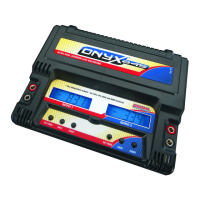7
CHARGE COMPLETE
When the charger has determined the battery is full it will automatically stop charge and show “END” on the LCD. Audible
tones will sound for about 10 seconds (pressing START while the tones are sounding will turn them off). Information
regarding the fi nished charge can be recalled by pressing the “DATA” button. Please refer to the fl ow chart on page 6 for
the data that can be recalled.
For NiCd and NiMH batteries, the trickle charge current value is
set automatically by the charger as shown in the chart at right, and
shown in amps “A”. The charger will remain in trickle charge mode
until the battery is disconnected from the charger, or the START
button is pressed again.
Trickle charge will NOT be applied to lithium batteries. When fast
charge ends, lithium batteries can be disconnected from the charger
and are ready for use.
If the fast charge 90-minute backup safety timer expires before the battery is fully charged, the display will show “STOP”.
If this occurs, you might want to attempt to re-charge the battery by starting another charge. Refer to the Trouble Shooting
Guide for more details.
CARE AND HANDLING OF NiMH BATTERIES
● DO NOT allow NiMH batteries to overheat! Disconnect overheated batteries from the charger immediately and
allow to cool.
● DO NOT attempt to use the charger’s lithium functions with NiMH batteries.
● Store NiMH packs with some voltage remaining on the cells (refer to battery supplier).
● It is important to recharge NiMH batteries immediately prior to use, as they have a high self-discharge rate.
● “AAA”, “AA” and “A” size radio batteries can safely be peak charged at currents up to 1.5C to 2C (battery capacity
1.5 or 2.0). High charge currents can overheat batteries and thus reduce service life, especially for smaller size cells.
CARE AND HANDLING OF LiPo, Li-Ion, and LiFe BATTERIES
WARNING!! DO NOT try to charge lithium-polymer (LiPo) or lithium-ion (Li-Ion) or LiFe cells in the
same way as other battery types! Always read the instructions that are included with your lithium
batteries carefully before use. Failure to follow these care and handling instructions can quickly
result in severe, permanent damage to the batteries and their surroundings and even start a FIRE!
● ALWAYS charge lithium batteries in a fi reproof location, which could be a container made of metal or ceramic
tile. Monitor the area with a smoke or fi re alarm, and have a lithium approved fi re extinguisher available at
all times.
● NEVER attempt to extinguish a lithium fi re with water or a non-lithium approved fi re extinguisher! Use ONLY a
“Class D” fi re extinguisher.
● ALWAYS provide adequate ventilation around LiPo/Li-Ion/LiFe batteries during charge, while in use, and during storage.
● NEVER allow LiPo, Li-Ion or LiFe cells to overheat at any time, as they can and usually will become physically
damaged and could possibly EXPLODE or catch FIRE!! If a battery becomes overheated (over 140°F, 60°C),
disconnect it from the charger IMMEDIATELY!
● NEVER continue to charge LiPo, Li-Ion or LiFe batteries if the charger fails to recognize full charge. LiPo and LiFe
cells which swell or emit smoke may be in an overcharge condition and should be disconnected from the charger
immediately.
● NEVER set the charger’s LiPo/Li-Ion/LiFe battery voltage settings to a voltage that is HIGHER than the nominal
rating of the battery itself, as such cells cannot handle overcharging in any way.
● NEVER charge LiPo, Li-Ion or LiFe batteries at currents greater than the maximum rated current as specifi ed by
the battery’s manufacturer.
● NEVER allow LiPo cells to come in contact with moisture or water at any time.
● NEVER allow the internal electrolyte from LiPo, Li-Ion or LiFe batteries to get in the eyes or on skin – wash affected
areas immediately if they come in contact with the electrolyte and contact your physician!
● NEVER attempt to use the charger’s NiCd and NiMH functions for LiPo or Li-Ion batteries.
● ALWAYS keep lithium batteries away from children.
0.8A
1.5A
3.0A
5.0A
0.05A (50mA)
0.10A (100mA)
0.15A (150mA)
0.25A (250mA)
Trickle Charge
Fast Charge
Current Setting
Approximate
Trickle Current

